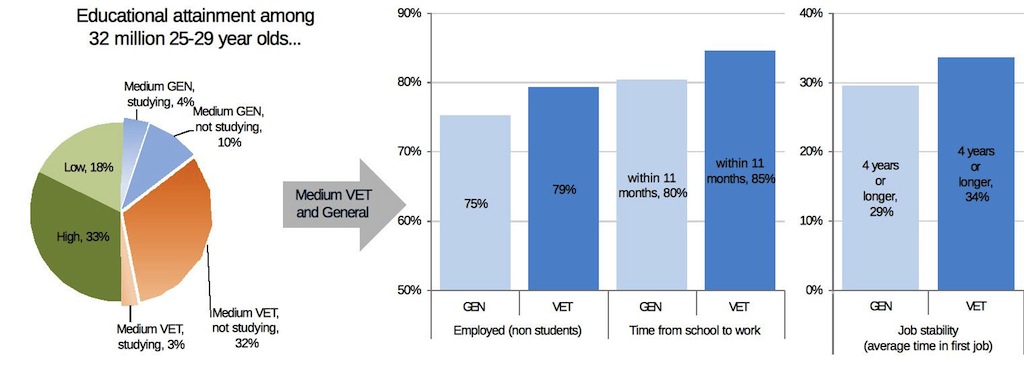Several indicators are considered in this survey. First, the 25-29 year-old population is broken down by level and orientation of educational attainment. For medium-level graduates of the same age, three more factors are taken into account: current employment rates for non-students, time elapsed from graduation to the first job lasting longer than three months, and length of time spent in the first job.
Key points
- A 79% of vocational education graduates at medium level were employed in 2009, compared to 75% for general graduates. The difference is twice as much for 20-24 year-old non-students (8.2%).
- VET graduates tend to find a job slightly more quickly: of employed 25-29 year-olds, 85% found a job within 11 months, compared to 80% for general graduates.
- VET graduates are more likely to stay longer in a job: 34% stayed in their first job for four years or longer, compared to 29% for general graduates. This could point to a slightly better match among VET graduates between the skills needed for the job and those of the individual.
- Although short-term employment prospects are better for vocational graduates, there are worrying signs, according to Cedefop’s medium-term skill forecast. Fewer job openings in occupations traditionally filled by VET graduates will be entirely new, compared to occupations usually filled by higher education graduates. In the longer term, vocational education graduates would be well advised to continue training to ensure their skills are up to date.
Notes
Data originate from the EU labour force survey ad hoc module 2009 on the entry of young people into the labour market, and are subject to its methodology. Data were processed by Cedefop based on extractions provided by Eurostat. In interpreting the data, possible differences in national implementations of the EU LFS should be taken into account.
Indicators on time from graduation to work and average time in the first job do not include Germany. The first job is a job lasting longer than three months. Data date back to 2009, at which point EU Member States had been affected by and responded to the crisis in different ways.
 These and similar findings are available in Cedefop’s new report, From education to working life: the labour market outcomes of vocational education and training
These and similar findings are available in Cedefop’s new report, From education to working life: the labour market outcomes of vocational education and training


